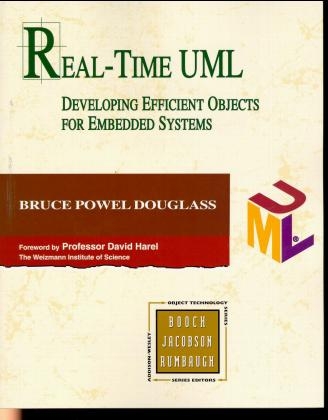
Real-Time UML
Addison Wesley (Verlag)
978-0-201-65784-5 (ISBN)
- Titel erscheint in neuer Auflage
- Artikel merken
"Real-Time UML, Second Edition,uniquely ties together the principal UML capabilities as they can apply to embedded, real-time systems. Real-time systems development is difficult; this book will help guide developers through some of the minefields." --Doug Locke, Lockheed Martin Corporation The increasing complexity of embedded and real-time systems requires a more premeditated and sophisticated design approach for successful implementation. The object-based Unified Modeling Language (UML) can describe the structural and behavioral aspects critical to real-time systems, and has come to the fore as an outstanding medium for effective design. Like its best-selling predecessor, Real-Time UML, Second Edition, provides an overview of the essentials of real-time systems and an introduction to UML that focuses on its use in design and development. The book examines requirements analysis, the definition of object structure and object behavior, architectural design, mechanistic design, and more detailed designs that encompass data structure, operations, and exceptions.
Numerous figures help illustrate UML design techniques, and detailed, real-world examples show the application of those techniques to embedded systems. This edition features version 1.3 of the UML standard and includes extensive coverage of the action semantics metamodel and statecharts, as well as further descriptions and demonstrations of how to effectively apply use cases and capture object models and state behavior. Real-Time UML, Second Edition, also introduces an elaboration of the author's proven product development process, Rapid Object-Oriented Process for Embedded Systems (ROPES), and a new appendix on the UML extension process. Key topic coverage includes: *Specifying external events *Identifying use cases *Response time *Concurrent collaboration diagrams *Key strategies for object-identification *Defining object state behavior *UML state diagrams *Orthogonal components and concurrency *Implementing state machines *Representing physical architecture in UML *Safety and reliability patterns *Concurrent state diagrams *Assigning priorities *State behavior patterns 0201657848B04062001
Bruce Powel Douglass is the Chief Evangelist for i-Logix, a leading producer of tools for real-time systems development. He contributed to the original specification of the UML and to the UML 2.0 as one of the co-chairs of the Object Management Group’s Real-Time Analysis and Design Working Group. Bruce consults for a number of companies and organizations, including NASA, on building large-scale, real-time, safety-critical systems. He is the author of seven other books, including Real-Time Design Patterns (Addison-Wesley, 2003) and Doing Hard Time (Addison-Wesley, 1999).
(Each chapter concludes with A Look Ahead and References.)
Figure List.
About the Author.
Foreword by David Harel.
Preface to the Second Edition.
Preface to the First Edition.
Acknowledgments.
1. Introduction to Real-Time Systems and Objects.
What is Special About Real-Time Systems?
Dealing with Time.
Model-Based Development.
Development Activities of the ROPES Process.
Advantages of Objects.
Object Orientation with UML.
Objects.
Attributes.
Behavior.
Messaging.
Concurrency.
Classes.
Relations among Classes and Objects.
UML Diagrams and Notation.
2. Requirements Analysis of Real-Time Systems.
Use Cases.
Actors.
Requirements.
Use Case Relations.
Using Use Cases.
Filling Out the Details of the Use Cases.
Scenarios.
Sequence Diagrams.
Message Properties.
Capturing Time and Timelines.
Statecharts and Use Cases.
Identifying Use Cases.
3. Analysis: Defining the Object Structure.
The Object Discovery Process.
Connecting the Object Model with the Use Case Model.
Key Strategies for Object-Identification.
Underline the Noun Strategy.
Identify the Casual Objects.
Identify Services (Passive Contributors).
Identify Real-World Items.
Identify Physical Devices.
Identify Key Concepts.
Identify Transactions.
Identify Persistent Information.
Identify Visual Elements.
Identify Control Elements.
Apply Scenarios.
Identifying Object Associations.
Object Attributes.
Discover Candidate Classes.
Class Diagrams.
Elevator Class Diagram Example.
Defining Class Relationships and Associations.
Associations.
Aggregations and Composition.
RTOS Example.
Associative Classes.
Generalization Relationships.
4. Analysis: Defining Object Behavior.
Object Behavior.
Simple Behavior.
State Behavior.
Continuous Behavior.
Defining Object State Behavior.
UML Statecharts.
Basic Statecharts.
And-States.
Submachines.
Inherited State Models.
Cardiac Pacemaker Example.
The Role of Scenarios in the Definition of Behavior.
Timing Diagrams.
Sequence Diagrams.
Event Hierarchies.
Defining Operations.
Types of Operations.
Strategies for Defining Operations.
5. Architectural Design.
Overview of Design.
What is Architectural Design?
Physical Architecture Issues.
Software Architecture Issues.
Representing Physical Architecture in UML.
Architectural Patterns.
Master-Slave Pattern.
Microkernel Pattern.
Proxy Pattern.
Broker Pattern.
Concurrency Design.
Representing Tasks.
System Task Diagram.
Concurrent State Diagrams.
Defining Threads.
Identifying Threads.
Assigning Objects to Threads.
Defining Thread Rendezvous.
Sharing Resources.
Assigning Priorities.
6. Mechanistic Design.
What is Mechanistic Design?
Mechanistic Design Patterns.
Simple Patterns.
Reuse Patterns.
7. Detailed Design.
What is Detailed Design?
Data Structure.
Data Collection Structure.
Associations.
Operations.
Visibility.
Algorithms.
Exceptions.
Summary.
Appendix A: Notational Summary.
Appendix B: The Future of the UML for Real-Time.
Index. 0201657848T04062001
| Erscheint lt. Verlag | 15.11.1999 |
|---|---|
| Verlagsort | Boston |
| Sprache | englisch |
| Maße | 187 x 234 mm |
| Gewicht | 566 g |
| Themenwelt | Informatik ► Software Entwicklung ► Objektorientierung |
| Informatik ► Software Entwicklung ► UML | |
| ISBN-10 | 0-201-65784-8 / 0201657848 |
| ISBN-13 | 978-0-201-65784-5 / 9780201657845 |
| Zustand | Neuware |
| Haben Sie eine Frage zum Produkt? |
aus dem Bereich



